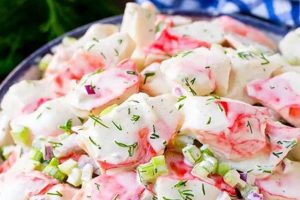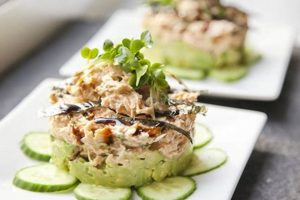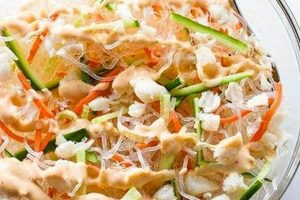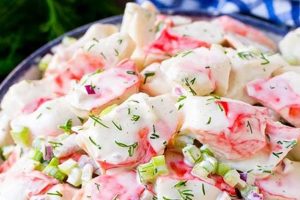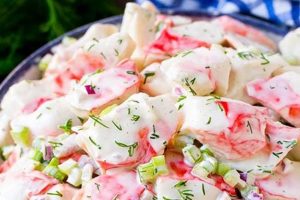A dish comprised of imitation crab meat combined with mayonnaise, seasonings, and often other ingredients like celery, onion, and relish creates a cost-effective and convenient alternative to traditional crab salad. This imitation crab, typically made from surimi (processed white fish), offers a similar texture and mild flavor profile to real crab, making it a popular choice for sandwiches, salads, or dips.
This accessible seafood alternative offers several advantages. It provides a budget-friendly option for those seeking the taste of crab without the higher price tag. Additionally, its consistent availability and shelf stability make it a practical choice for meal planning. Historically, surimi has a long tradition in Asian cuisine, and its modern adaptation as imitation crab has broadened its appeal globally, leading to numerous variations in salad preparations.
This exploration will delve into various aspects of creating this versatile dish, including selecting appropriate ingredients, mastering preparation techniques, and discovering creative serving suggestions.
Tips for an Excellent Imitation Crab Salad
Creating a delicious imitation crab salad involves attention to detail and thoughtful ingredient selection. The following tips will help elevate this simple dish to a culinary delight.
Tip 1: Quality Surimi Selection: Opt for high-quality surimi with a firm texture and a delicate, slightly sweet flavor. Avoid products with an overly fishy odor or a mushy consistency.
Tip 2: Mayonnaise Matters: The choice of mayonnaise significantly impacts the overall flavor. A classic mayonnaise works well, but experimenting with flavored varieties like sriracha mayo or wasabi mayo can add a unique twist.
Tip 3: Freshness is Key: Utilize fresh ingredients whenever possible. Crisp celery and finely diced red onion provide a welcome crunch and brightness.
Tip 4: Seasoning with Balance: Seasoning should enhance, not overpower, the delicate flavor of the surimi. A touch of Old Bay seasoning, lemon juice, or dill can complement the other ingredients beautifully.
Tip 5: Mindful Ingredient Incorporation: Gently fold ingredients together to avoid breaking down the surimi and creating a mushy texture. A light touch ensures a pleasant mouthfeel.
Tip 6: Chill Time Enhances Flavor: Allowing the salad to chill for at least 30 minutes before serving allows the flavors to meld and deepen, creating a more cohesive and enjoyable experience.
Tip 7: Creative Serving Suggestions: Consider serving the salad on croissants, lettuce wraps, or crackers. It also makes a delicious filling for deviled eggs or a topping for avocado toast.
By following these tips, one can create an imitation crab salad that rivals traditional crab salad in both flavor and presentation. Careful ingredient selection, balanced seasoning, and proper chilling are essential for achieving optimal results.
These practical tips pave the way for a truly enjoyable culinary creation.
1. Ingredients
Ingredient selection significantly impacts the final quality and flavor profile of imitation crab salad. The delicate flavor of the surimi requires careful consideration of complementary ingredients. High-quality imitation crab meat forms the foundation, ensuring a desirable texture and taste. Fresh vegetables like celery and red onion contribute crispness and brightness, counterbalancing the richness of the mayonnaise. Seasonings, judiciously applied, enhance the overall flavor profile without masking the subtle sweetness of the surimi. For instance, a touch of Old Bay seasoning complements the seafood notes, while a squeeze of lemon juice adds a refreshing acidity. The interplay of these ingredients creates a balanced and harmonious flavor experience.
Practical application of ingredient knowledge allows for customization and creativity. Substituting finely diced bell peppers for celery introduces a different textural element and a subtly sweet flavor. Incorporating chopped fresh herbs like dill or chives elevates the salad with aromatic complexity. Understanding the role of each ingredient empowers informed choices, leading to personalized variations that cater to individual preferences. For example, a spicy variation might include diced jalapeos and a drizzle of sriracha, while a more traditional approach might utilize sweet pickle relish for a tangy counterpoint.
Careful ingredient selection is essential for crafting a superior imitation crab salad. The quality and freshness of the components directly influence the final product’s taste and texture. Thoughtful consideration of flavor pairings and textural contrasts elevates this seemingly simple dish. Ultimately, understanding the role and impact of each ingredient unlocks the potential for culinary creativity and personalized enjoyment.
2. Preparation
Proper preparation techniques are crucial for a successful imitation crab salad. These techniques ensure the desired texture, prevent the salad from becoming watery, and maximize flavor development. Careful attention to detail throughout the preparation process elevates the final dish.
- Ingredient Handling
Gentle handling of ingredients, particularly the imitation crab meat, preserves its delicate texture. Rough handling can shred the surimi, resulting in a less appealing, mushy consistency. For example, imitation crab should be flaked rather than chopped. Vegetables should be diced uniformly for even distribution and a pleasant mouthfeel. This careful approach contributes to a visually appealing and texturally satisfying salad.
- Mixing Technique
The mixing technique employed significantly impacts the final texture. Overmixing can lead to a dense and compact salad. A light folding motion ensures that the ingredients are evenly distributed without crushing the delicate surimi. This creates an airy and palatable texture. Proper mixing also facilitates even distribution of flavors throughout the salad.
- Chilling Time
Chilling the prepared salad allows the flavors to meld and develop fully. A minimum of 30 minutes in the refrigerator enhances the overall flavor profile, allowing the individual components to harmonize. This crucial step creates a more cohesive and flavorful salad. The chilling process also firms the salad, making it easier to handle and serve.
- Drainage
Excess moisture can dilute the flavors and create a watery salad. Proper drainage of ingredients, particularly vegetables like celery and onion, is essential. Patting these ingredients dry after chopping helps maintain the desired consistency and prevents excess liquid from accumulating in the final product. This attention to detail ensures a well-balanced and flavorful salad.
These preparatory steps contribute significantly to the overall quality and enjoyment of the final dish. Attention to detail in each stage ensures a balanced flavor profile, desirable texture, and an appealing presentation. Mastering these techniques elevates the imitation crab salad from a simple dish to a carefully crafted culinary creation.
3. Flavor Balance
Flavor balance is paramount in a successful imitation crab salad recipe. The inherent mildness of surimi necessitates a careful orchestration of complementary flavors. Dominant ingredients can easily overpower the subtle sweetness of the imitation crab, resulting in a disharmonious profile. A balanced approach allows the nuanced flavors of each component to contribute to the overall taste experience, creating a cohesive and enjoyable dish.
Consider the interplay of mayonnaise, seasonings, and vegetables. Mayonnaise provides a creamy richness that serves as a foundation for the other flavors. However, an excessive amount can mask the delicate taste of the surimi. Seasonings, such as Old Bay, dill, or lemon juice, enhance the seafood notes and provide complexity. Yet, over-seasoning can create an imbalance, overpowering the subtle sweetness of the imitation crab. Fresh vegetables, like celery and onion, offer crispness and brightness. Their flavors, while important, should not dominate the overall profile. A judicious balance of these elements is crucial for a well-rounded and flavorful salad. For instance, a touch of Dijon mustard can add a subtle tanginess that complements the richness of the mayonnaise without overwhelming the surimi. Similarly, a small amount of finely diced red onion provides a piquant bite that enhances the overall flavor profile without overpowering the other ingredients.
Achieving flavor balance requires careful consideration of each ingredient’s contribution and its interaction with the others. It involves understanding the inherent flavors of each component and how they combine to create a harmonious whole. This understanding allows for informed decisions regarding ingredient proportions and seasoning choices. The ultimate goal is a salad where no single flavor dominates, but rather a symphony of tastes that complement and enhance each other, resulting in a truly delightful culinary experience. Failure to achieve this balance can result in a dish that is either bland and uninteresting or overly seasoned and unbalanced. A well-balanced imitation crab salad, on the other hand, showcases the subtle sweetness of the surimi while allowing the supporting ingredients to shine, creating a complex and satisfying flavor profile.
4. Texture
Texture plays a crucial role in the overall enjoyment of imitation crab salad. The interplay of various textural elements creates a dynamic and satisfying sensory experience. A successful recipe balances the delicate texture of the surimi with contrasting textures from other ingredients. This contrast prevents a monotonous mouthfeel and elevates the dish beyond a simple mixture of ingredients.
The inherent tenderness of imitation crab meat provides a soft foundation. Incorporating crisp elements, such as finely diced celery or water chestnuts, introduces a contrasting crunch. This interplay of soft and crisp textures creates a more engaging and enjoyable culinary experience. For example, the subtle snap of diced celery complements the soft, flaky texture of the surimi, creating a dynamic contrast that enhances each bite. Similarly, the addition of chopped red onion provides a slightly sharp, crisp texture that further diversifies the mouthfeel. Failing to consider textural variety can result in a bland and homogenous texture that diminishes the overall appeal of the salad.
Understanding the impact of textural elements allows for strategic ingredient selection and preparation techniques. Dicing vegetables uniformly ensures a consistent textural experience throughout the salad. Avoiding overmixing prevents the breakdown of ingredients and maintains the desired textural contrasts. Proper drainage of ingredients, especially vegetables, prevents excess moisture from compromising the overall texture and creating a watery salad. Ultimately, careful consideration of texture elevates the imitation crab salad from a simple dish to a multi-faceted culinary creation that delights the palate with its diverse textural interplay.
5. Serving Suggestions
Serving suggestions enhance the versatility and enjoyment of imitation crab salad, transforming it from a simple mixture into a diverse culinary component. Thoughtful presentation elevates the dining experience, moving beyond basic functionality to engage aesthetic and practical considerations. The choice of serving vessel or accompaniment significantly influences the perceived flavor profile and overall appeal. For example, serving the salad on crisp lettuce cups provides a refreshing contrast to the creamy texture, while using buttery croissants offers a richer, more indulgent experience. These choices cater to different palates and occasions, showcasing the adaptability of the dish.
Practical applications demonstrate the transformative power of serving suggestions. Consider the difference between serving the salad as a sandwich filling versus presenting it as an appetizer on endive spears. The former offers a convenient and portable meal, ideal for a casual lunch. The latter, however, transforms the salad into an elegant hors d’oeuvre, suitable for a more formal setting. Similarly, incorporating the salad into a larger dish, such as a stuffed tomato or avocado, adds complexity and visual appeal. These examples illustrate how serving suggestions can redefine the role of imitation crab salad, expanding its culinary potential beyond a standalone dish.
Effective serving suggestions consider both flavor and presentation. Pairing the salad with complementary flavors and textures enhances the overall dining experience. For instance, serving the salad alongside a zesty lemon vinaigrette or a crisp, acidic slaw creates a balanced and refreshing combination. Conversely, pairing it with richer accompaniments, like avocado slices or toasted baguette slices, creates a more decadent experience. Careful consideration of these elements ensures that the serving suggestion enhances, rather than detracts from, the overall enjoyment of the imitation crab salad. Understanding the impact of presentation allows one to tailor the serving style to the specific occasion and desired culinary experience, ultimately maximizing the versatility and enjoyment of this adaptable dish.
6. Variations
Variations within imitation crab salad recipes demonstrate the adaptability of this dish, transforming it from a basic staple into a canvas for culinary creativity. The core recipe, consisting of imitation crab, mayonnaise, and seasonings, provides a foundation upon which numerous flavor profiles and textures can be built. This adaptability stems from the surimi’s neutral flavor profile, which readily accepts and complements a wide range of ingredients. For example, incorporating diced mango and a touch of sriracha creates a sweet and spicy variation, while adding Old Bay seasoning and chopped celery evokes a classic Maryland-style crab salad. These variations not only cater to diverse palates but also allow for seasonal adaptations, incorporating fresh ingredients readily available throughout the year.
The practical significance of understanding variations lies in the ability to personalize the dish. Dietary restrictions can be accommodated by substituting ingredients. For instance, using a vegan mayonnaise allows for a plant-based version, while gluten-free crackers or bread ensure accessibility for those with gluten sensitivities. Furthermore, variations can be tailored to specific occasions. A simple celery and onion variation suits a casual lunch, while a more elaborate version with avocado, mango, and a citrus vinaigrette elevates the dish for a special occasion. This flexibility makes imitation crab salad a versatile option for a variety of culinary needs.
Exploring variations within imitation crab salad recipes unlocks its full potential. Understanding the interplay of flavors and textures empowers culinary experimentation and personalized creations. The inherent adaptability of the base recipe allows for both simple and complex variations, catering to diverse tastes and dietary needs. Ultimately, embracing variations transforms this seemingly simple dish into a versatile and exciting culinary platform.
Frequently Asked Questions
This section addresses common inquiries regarding imitation crab salad, providing concise and informative responses to clarify potential uncertainties and enhance understanding.
Question 1: What is imitation crab meat made of?
Imitation crab meat, also known as surimi, is primarily made from processed white fish, typically pollock, combined with starch, sugar, salt, and other additives to mimic the flavor and texture of real crab.
Question 2: Is imitation crab salad healthy?
While a convenient and affordable option, imitation crab salad is generally not considered as healthy as real crab salad due to its lower protein content and the presence of additives. Nutritional value varies based on specific ingredients.
Question 3: How long can imitation crab salad be stored?
Properly stored in an airtight container in the refrigerator, imitation crab salad typically lasts for 3-5 days. Always check for spoilage before consumption.
Question 4: Can imitation crab salad be frozen?
Freezing is not recommended, as it can negatively affect the texture of the salad, making it watery upon thawing. It is best consumed fresh.
Question 5: How can one improve the flavor of imitation crab salad?
Using high-quality surimi, fresh ingredients, and balanced seasonings enhances the flavor profile. Experimenting with different herbs, spices, and add-ins like diced vegetables or fruits allows for customization.
Question 6: What are some alternatives to mayonnaise in imitation crab salad?
Plain Greek yogurt or a mixture of Greek yogurt and mayonnaise offer a lighter alternative, reducing overall fat content while maintaining a creamy texture. Avocado can also be used for a vegan and healthier option.
Understanding the composition, storage, and potential modifications of imitation crab salad empowers informed choices regarding consumption and preparation.
This FAQ section provides a foundation for further exploration of imitation crab salad recipes and variations.
Conclusion
Exploration of the multifaceted aspects of imitation crab salad recipes reveals a dish offering both convenience and culinary potential. From ingredient selection and preparation techniques to flavor balancing, textural considerations, and serving suggestions, each element contributes to the final product’s success. Understanding the core components and their interplay empowers informed choices, allowing for personalized variations that cater to individual preferences and dietary needs. The versatility of this dish extends beyond its basic form, providing a platform for culinary creativity and adaptation.
Imitation crab salad, often perceived as a simple dish, presents an opportunity for culinary exploration and personalized expression. Thoughtful consideration of each element, from ingredient quality to presentation, elevates this dish beyond mere convenience food. Further exploration and experimentation promise continued enjoyment and discovery within the realm of imitation crab salad recipes.

